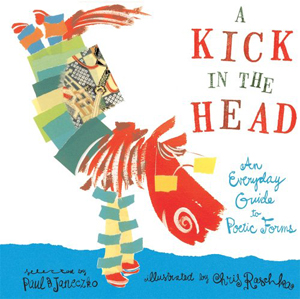
The Horn Book website has lots of material of interest to teachers. Here are some areas to explore. And follow us on Twitter: #lollysclass
|
Interviews with authors and illustrators Recommended books -- reviews and themed book lists |
School -- reading in school, author visits, and more Suggestion box: what else to you want to see in Lolly's Classroom? |
A Kick in the Head | Class #5, 2015
This is one of those books for kids that tends to be an eye-opener for most adults, too.
 This is one of those books for kids that tends to be an eye-opener for most adults, too. Who knew there were this many poetry forms out there?!
This is one of those books for kids that tends to be an eye-opener for most adults, too. Who knew there were this many poetry forms out there?!Notice how the book could be enjoyed by just reading the poems. OR, if you want to learn more, you can see what the form is and use Chris Raschka's symbols to help you remember. If you want even MORE, read the super-small print at the bottom of the page.
I hope you will all take time to read Janescko's excellent introduction. He's a teacher himself and knows how to explain poetry in ways that everyone can understand. Why all the rules? Well, would a basketball game be any fun to watch if there were no rules? Same with poetry. But he's also good on why it's okay to break the rules sometimes.
Most of all, I implore you NOT to read this book fast or all at once. If you were sharing this with children, you certainly wouldn't. If you have to read it under time pressure (e.g. on reserve), then try to imagine it being read with children just a little bit at a time.

RELATED
RECOMMENDED
ALREADY A SUBSCRIBER? LOG IN
We are currently offering this content for free. Sign up now to activate your personal profile, where you can save articles for future viewing.







Add Comment :-
Comment Policy:
Comment should not be empty !!!
Samantha Song
I see this book as a very practical guide to a poetry unit for teachers and students. A teacher can very easily pull some great poetry exemplars from this single text to share and instruct on its multiple forms. The illustrations are lively and reflective of the text and the little illustrated reminders in the top left and right hand corner are also fun. Teachers and students can use this book as a great reference for straightforward definitions and examples.Posted : Mar 31, 2015 05:20
Annie Thomas
This book is digestible in small chunks and would be perfect for a fun read or to teach a specific type of poetry. I can imagine students getting very excited as their skills and knowledge grow to continue reading down the page to get to the rules or to learn more about a specific type of poetry. I love this style of art for the illustrations. This book is truly art. The pictures that depict each poem are very memorable and children can tie them to what they have just read and learned. I love the basketball image and how it ties together the concept of working up to being able to dunk. A older child might identify with this as one player jumping to score the basket, while a younger child might see this as the player getting bigger.Posted : Mar 31, 2015 12:40
Zohal Atif
A kick in the head- does feel like a kick in the head. With its illustrations that look like a cross between water color and origami paper it awakens the senses. The bright and colorful illustrations brought poetry which normally perceived as adult sphere to children's world and made it more interesting. And also the illustrations had a touch of mystery to them. Even though they depicted the subject of the poem but just like a poem that depends on the reader to take away things that touches them, the illustrations felt that more than one form could be seen. All the forms of poetry were very interesting to read. But since poetry is challenging as it is, wish the poems chosen followed the rules of that specific form rather than venture out. Its tough to wrap your head around a poem and its form and when the poem does not follow the form described its even more challanging. Also, some poems were little dark for children’s book. On page 24 “History Lesson” by Allan Wolf says “Cut off their heads and displayed them on sticks.” It may be historically true but didn't belong on this colorful, full of life book of poems.Posted : Mar 28, 2015 10:35
Lindsey Bailey
I used this book with my 3rd graders to introduce poetry week last April, and they LOVED it. We would read a poem or two a day, and talk about the forms and what we like about them. They especially loved the found poems , and the concrete poems - it was amazing to see how inspired they were.Posted : Mar 27, 2015 01:38